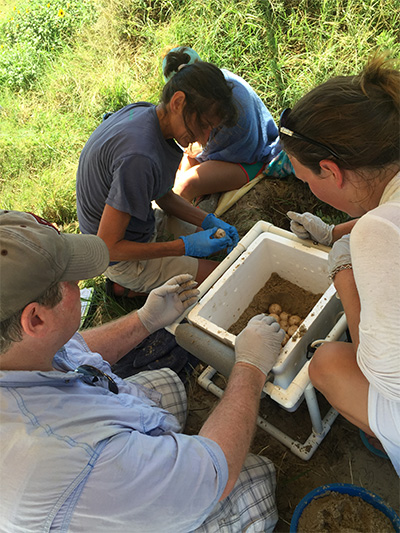Texas A&M Galveston’s sea turtle patrol is back in action as turtles return to nest on Texas beaches
Last week the Upper Texas Coast Sea Turtle Patrol, which is a collaboration of Texas A&M University at Galveston and Turtle Island Restoration Network, found their first Kemp’s ridley sea turtle nest. In addition, the patrol was able to examine the turtle after it laid its eggs, which provides important information to sea turtle biologists.

One part of a routine examination of any post-nesting turtle is to determine if the individual has any identification tags. Typically, identification tags are attached to the trailing edge of a sea turtle foreflipper and a Passive Integrated Transponder (PIT) tag is place under the skin of the foreflipper. A PIT tag provides a positive ID number when scanned with a reader. This electronic tag is similar to an electronic “chip” that many pet owners get for their dog or cat at their veterinarian’s office.
“Our turtle had an active PIT tag,” said Dr. Christopher Marshall of Texas A&M University at Galveston. “The PIT tag allowed us to identify if this animal had nested on the Upper Texas Coast before. With the help of Lyndsey Howell with the National Oceanic and Atmospheric Administration (NOAA) and Dr. Donna Shaver, with the Padre Island National Seashore, we discovered that this turtle had laid a nest on Galveston Island 11 years ago in 2006. Our first 2017 Kemp’s ridley sea turtle likely came to the Texas coast to nest every 2 to 3 years to lay her eggs since her capture in 2006, but was not captured again until this year. Such long-term data is valuable to managing these endangered species.”
Sea turtle patrols perform an important service. The Kemp’s ridley is the most endangered sea turtle in the world and only nest in the western Gulf of Mexico. Their primary nesting beaches are in Mexico and South Texas but turtles do nest on the Upper Texas Coast. Due to their critically endangered status, volunteers patrol Texas beaches from April 1st to July 15th every year looking for turtle tracks in an effort to find and carefully excavate the nests. The Upper Texas Coast Sea Turtle Patrol is part of a state-wide effort to protect these beautiful turtles. Dr. Donna Shaver is the Director of the Sea Turtle Science and Recovery Division of the Padre Island National Seashore (PAIS) and runs the state-wide effort.
Conservationists work in collaboration with NOAA Fisheries, U.S. Fish and Wildlife Service and Texas Parks and Wildlife Department. All excavated eggs are transported to an incubation facility (PAIS) to hatch. These efforts are important since eggs in this facility have a greater hatching success than in the wild. Since sea turtle sex is determined by nest temperature, the facility is able to raise mostly females, which benefits the population.
Sea turtle patrols efforts up and down the coast are possible through funding as part of the Deepwater Horizon natural resource damage assessment settlement from the state and federal natural resource trustees, which include the Texas Parks Wildlife Department, the Texas Commission on Environmental Quality, the Texas General Land Office, the U.S. Department of the Interior and NOAA.
For those wishing to learn more about the project, additional information can be found at the Upper Texas Coast Sea Turtle Patrol website at https://www.tamug.edu/seaturtlepatrol/.